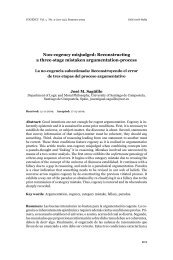Cogency v2 n2
Cogency v2 n2
Cogency v2 n2
You also want an ePaper? Increase the reach of your titles
YUMPU automatically turns print PDFs into web optimized ePapers that Google loves.
You can’t step into the same Argument twice: Wittgenstein... / D. H. COHEN<br />
but there are no quotation marks for the second question (But what is the<br />
meaning of the word “five”?), so even though the question sounds like it<br />
should be coming from the same voice’s standpoint there is some uncertainty<br />
about it. It could well be the same interlocutor but it could also be a<br />
new speaker, or Wittgenstein himself raising the question, or a question<br />
that a reader might – or perhaps even should – ask. There is something<br />
dissonant about the second question. It does not address the shopkeeper’s<br />
behavior at all, turning instead to meanings and the words themselves. It is,<br />
in a word, philosophical, and that makes it stand apart as much as if it were<br />
written in a different color or font. But the question also stands out because<br />
its ownership is ambiguous. It could even be the reader’s question – but<br />
only because the reader has not yet been freed from asking questions like<br />
that!<br />
In the Investigations, Wittgenstein often uses quotation marks for things<br />
said by imaginary or arbitrary people who present ideas which are then critiqued<br />
or used as springboards for internal dialogue. For example “It is as if<br />
someone were to say: ‘A game consists in moving objects...’” (§3) or “Imagine<br />
someone’s saying: ‘All tools serve to modify something...’” (§14). But his<br />
internal dialogue is often as not carried out without those quotation marks,<br />
and there are often sentences which seem to belong to a different voice, or<br />
where the voicing is unclear. This passage from Investigations §6 is typical:<br />
This ostensive teaching of words can be said to establish an association<br />
between the word and the thing. But what does this mean? Well, it may<br />
mean various things; but one very likely thinks first of all that a picture<br />
of the object comes before the child’s mind when it hears the word. But<br />
now, if this does happen–is it the purpose of the word? –Yes, it may be<br />
the purpose.–I can imagine such a use of words (or series of sounds).<br />
(Uttering a word is like striking a note on the keyboard of the imagination.<br />
In this passage, the words “Yes, it may be the purpose” can be read as<br />
coming from a different voice but it does not have to be read that way, nor<br />
does any other passage in the text. Some passages stretch the limits of single<br />
voice narration more than others. Consider this passage:<br />
35








